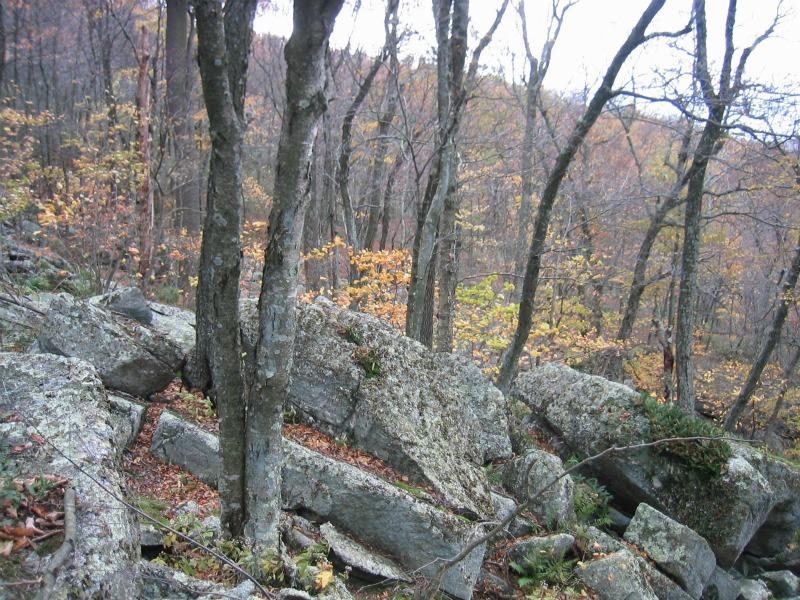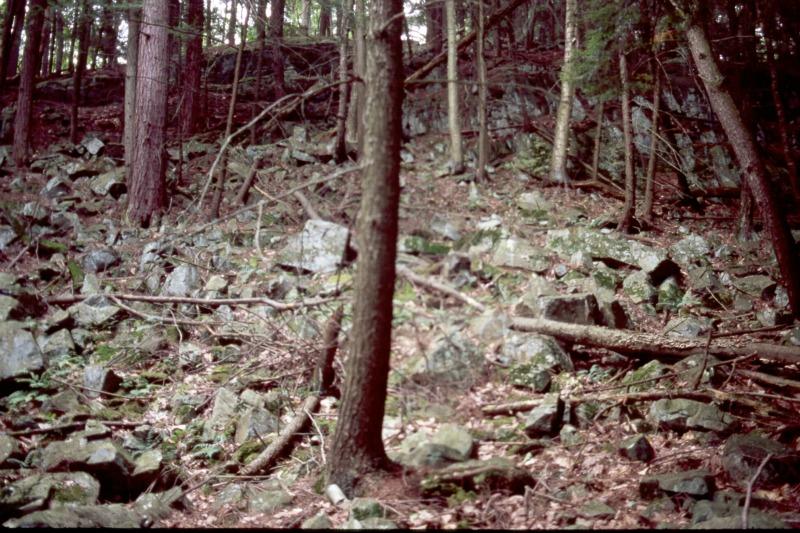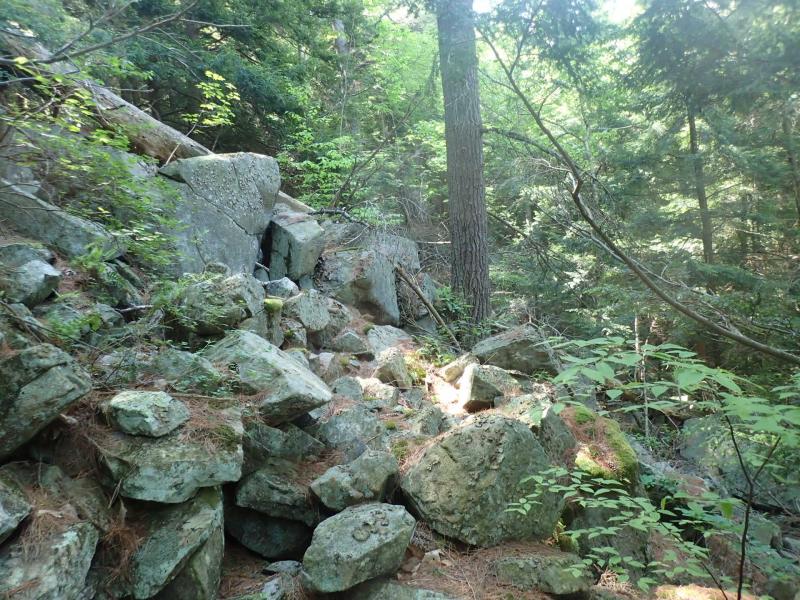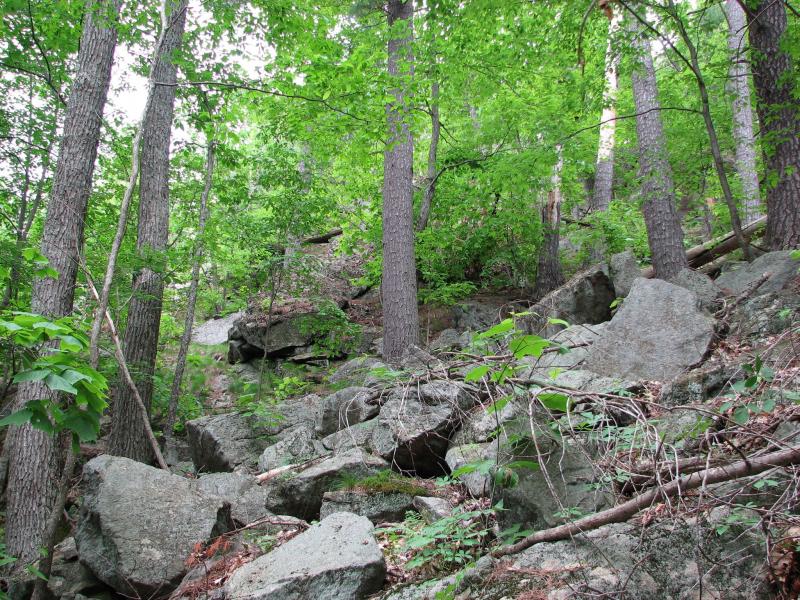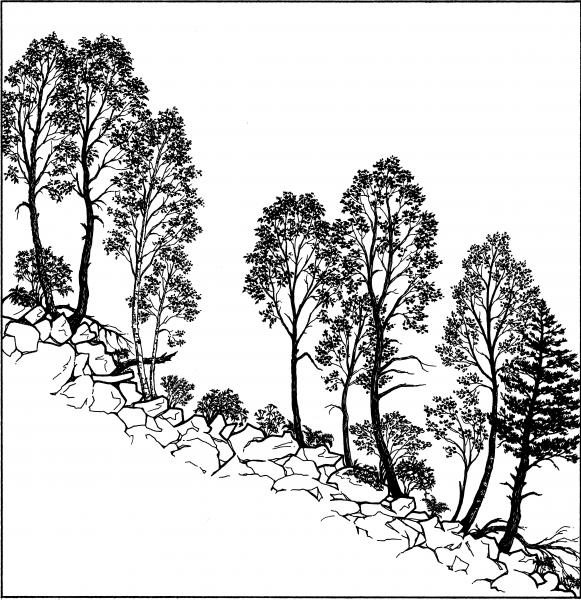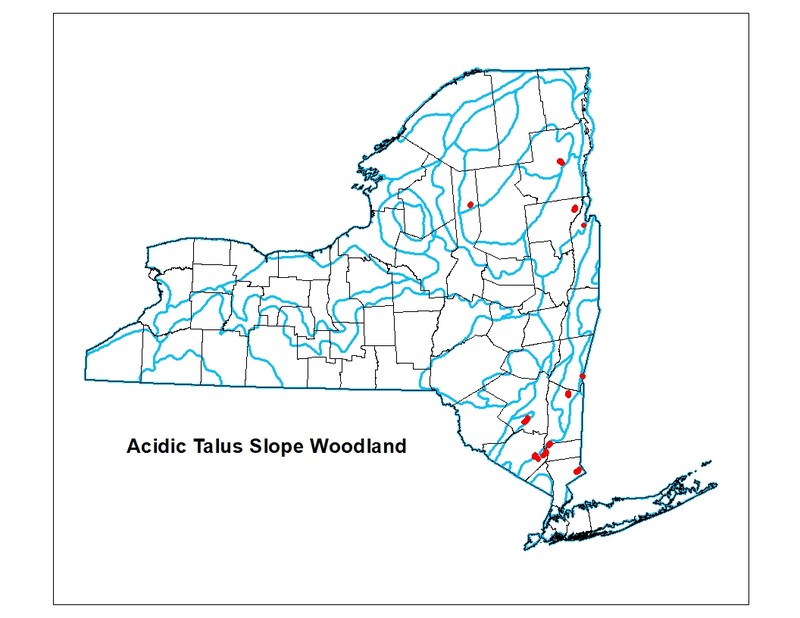Acidic Talus Slope Woodland
- System
- Terrestrial
- Subsystem
- Barrens And Woodlands
- State Protection
- Not Listed
Not listed or protected by New York State.
- Federal Protection
- Not Listed
- State Conservation Status Rank
- S3
Vulnerable in New York - Vulnerable to disappearing from New York due to rarity or other factors (but not currently imperiled); typically 21 to 80 populations or locations in New York, few individuals, restricted range, few remaining acres (or miles of stream), and/or recent and widespread declines.
- Global Conservation Status Rank
- G4?
Apparently Secure globally (most likely) - Conservation status is uncertain, but most likely uncommon in the world but not rare; usually widespread, but may be rare in some parts of its range; possibly some cause for long-term concern due to declines or other factors. More information is needed to assign a firm conservation status.
Summary
Did you know?
What is talus? Talus, or scree, is a steep, rocky slope usually found at the base of a mountain. The block size of the talus is strongly influenced by the type of rock forming the cliff face and rate of erosion. Shale or rapidly eroding sandstone forms unstable small loose talus as it is eroded from the mountain's face. The unstable nature of shale results in uneven slopes and many small rock crevices. Other bedrock, such as hard dolostone caprock, produces stable, very large talus that provides habitat for larger organisms.
State Ranking Justification
There are several hundred occurrences statewide. A few documented occurrences have good viability and some are protected on public land or private conservation land. This community is limited to areas with acidic talus across the state, and includes several large, high quality examples. The current trend of this community is probably stable for occurrences on public land, or declining slightly elsewhere due to moderate threats related to development pressure.
Short-term Trends
The number and acreage of acidic talus slope woodlands in New York have remained stable in recent decades.
Long-term Trends
The number and acreage of acidic talus slope woodlands in New York have probably declined substantially from historical numbers as a result of excessive logging and development.
Conservation and Management
Threats
The primary threats to acidic talus slope woodlands include recreational overuse (e.g., ATVs and hiking ) and invasive species (e.g., insects, diseases, and plants). Acidic talus slope woodlands are also threatened by development, either directly within the community or in the surrounding landscape. Other threats include habitat alteration (e.g., roads, excessive logging). Several acidic talus slope woodlands are threatened by invasive species, such as Japanese Angelica tree (Aralia elata) and garlic mustard (Alliaria petiolata). Acidic talus slope woodlands dominated by white ash (Fraxinus americana) may be threatened by the spread of the emerald ash borer (Agrilus planipennis), an insect responsible for the death or decline of large numbers of white ash.
Conservation Strategies and Management Practices
Minimize and/or avoid habitat alteration within the woodland and surrounding landscape. Prevent recreational overuse. Prevent the spread of invasive exotic species into the woodland through appropriate direct management, and by minimizing potential dispersal corridors, such as trails and roads.
Development and Mitigation Considerations
A natural (usually forested) buffer around the edges of this community will help it maintain the micro-climatic characteristics that make it unique.
Inventory Needs
Inventory more acidic talus slopes for this community across the state, perhaps using GIS modeling to locate new occurrences.
Research Needs
Determine if there are ecoregional variants based on dominant vegetation. Assess the extent of ash decline in this community throughout the state.
Rare Species
- Aconitum noveboracense (Northern Monkshood) (guide)
- Adoxa moschatellina (Musk Root) (guide)
- Aquila chrysaetos (Golden Eagle) (guide)
- Borodinia missouriensis (Green Rock Cress) (guide)
- Bubulcus ibis (Cattle Egret) (guide)
- Carex merritt-fernaldii (Fernald's Sedge) (guide)
- Carex nigromarginata (Black-edged Sedge) (guide)
- Carex retroflexa (Reflexed Sedge) (guide)
- Crepidomanes intricatum (Weft Fern) (guide)
- Crotalus horridus (Timber Rattlesnake) (guide)
- Haliaeetus leucocephalus (Bald Eagle) (guide)
- Myotis leibii (Eastern Small-footed Myotis) (guide)
- Myotis septentrionalis (Northern Long-eared Bat) (guide)
- Neotoma magister (Allegheny Woodrat) (guide)
- Ranunculus micranthus (Small-flowered Buttercup) (guide)
- Solidago randii (Rand's Goldenrod) (guide)
Range
New York State Distribution
This community is currently known from the lower Hudson Valley within the Hudson Highlands, the Shawangunk Mountains, and the Taconic Foothills. Acidic talus slope woodlands are also known from the Adirondack Mountains within the Eastern Adirondack Low Mountains (Lake George Valley) and the Adirondack High Peaks. Additional occurrences may be located elsewhere in the state where similar environmental conditions are possible.
Global Distribution
The range is estimated to span north to southern Canada, west to Ohio, south to Tennessee and North Carolina, and northeast to Nova Scotia.
Best Places to See
- Schunnemunk State Park (Orange County)
- Hudson Highlands State Park (Putnam County)
- Taconic State Park
- Ward Pound Ridge Reservation (Westchester County)
Identification Comments
General Description
An open to closed canopy woodland that occurs on talus slopes composed of non-calcareous bedrock such as granite, quartzite, or schist.
Characters Most Useful for Identification
The combination of vegetation indicating acidic soils and open areas showing a broken-up rocky slope (talus) generally identifies this community. Acidic tolerant trees include chestnut oak, red oak, white oak, white pine, red pine, paper birch, black birch, and mountain paper birch. Rock polypody is a fern often found on the rocks.
Elevation Range
Known examples of this community have been found at elevations between 210 feet and 2,300 feet.
Best Time to See
Trees and shrubs on acidic talus slope woodlands often change color earlier in the season than nearby, slightly less stressed forests. Thus, late summer and early fall is a good time to see this community for its early color.
Acidic Talus Slope Woodland Images
Classification
International Vegetation Classification Associations
This New York natural community encompasses all or part of the concept of the following International Vegetation Classification (IVC) natural community associations. These are often described at finer resolution than New York's natural communities. The IVC is developed and maintained by NatureServe.
- Yellow Birch - Northern Red Oak / Rock Polypody Talus Woodland (CEGL006584)
- (Rock Polypody, Appalachian Polypody) / Lichens Nonvascular Vegetation (CEGL006534)
NatureServe Ecological Systems
This New York natural community falls into the following ecological system(s). Ecological systems are often described at a coarser resolution than New York's natural communities and tend to represent clusters of associations found in similar environments. The ecological systems project is developed and maintained by NatureServe.
- Laurentian-Acadian Acidic Cliff and Talus (CES201.569)
- North-Central Appalachian Acidic Cliff and Talus (CES202.601)
- Northern Atlantic Coastal Plain Heathland and Grassland (CES203.895)
Characteristic Species
-
Trees > 5m
- Acer pensylvanicum (striped maple)
- Acer saccharum (sugar maple)
- Betula alleghaniensis (yellow birch)
- Betula lenta (black birch)
- Betula papyrifera (paper birch)
- Fraxinus americana (white ash)
- Pinus strobus (white pine)
- Quercus montana (chestnut oak)
- Quercus rubra (northern red oak)
-
Shrubs 2 - 5m
- Alnus incana ssp. rugosa (speckled alder)
- Hamamelis virginiana (witch-hazel)
- Sambucus racemosa (red elderberry)
-
Shrubs < 2m
- Kalmia latifolia (mountain laurel)
- Viburnum dentatum var. lucidum (smooth arrowwood)
-
Herbs
- Aralia nudicaulis (wild sarsaparilla)
- Carex pensylvanica (Pennsylvania sedge)
- Dryopteris marginalis (marginal wood fern)
- Polypodium virginianum (Virginian rock polypody, Virginian polypody)
- Polystichum acrostichoides (Christmas fern)
-
Nonvascular plants
- crustose lichens
- moss
Similar Ecological Communities
- Calcareous cliff community
(guide)
Calcareous cliff communities occur on a different rock type and tend to be steeper and have fewer trees than the acidic talus slope woodland.
- Calcareous talus slope woodland
(guide)
Calcareous talus slope woodlands occur on limestone or dolomite and have sugar maple, white ash, or basswood in the tree canopy. Whereas, acidic talus slope woodlands occur on talus slopes composed of non-calcareous bedrock such as granite, quartzite, or schist and have oaks and birches in the tree canopy.
- Cliff community
(guide)
Cliff communities are steeper and have fewer trees than the acidic talus slope woodland.
- Shale cliff and talus community
(guide)
Shale cliff and talus communities tend to be steeper and have few to no trees on shale rock. Whereas, acidic talus slope woodlands are not as steep and have at least 25% cover of trees on more acidic rock, such as granite, quartzite, or schist.
- Shale talus slope woodland
(guide)
While both communities have at least 25% cover trees on talus, shale talus slope woodlands occur on shale talus instead of the granite, quartzite, or schist talus of the acidic talus slope woodland.
Vegetation
Percent cover
This figure helps visualize the structure and "look" or "feel" of a typical Acidic Talus Slope Woodland. Each bar represents the amount of "coverage" for all the species growing at that height. Because layers overlap (shrubs may grow under trees, for example), the shaded regions can add up to more than 100%.
Additional Resources
References
Edinger, G. J., D. J. Evans, S. Gebauer, T. G. Howard, D. M. Hunt, and A. M. Olivero (editors). 2014. Ecological Communities of New York State. Second Edition. A revised and expanded edition of Carol Reschke’s Ecological Communities of New York State. New York Natural Heritage Program, New York State Department of Environmental Conservation, Albany, NY. https://www.nynhp.org/ecological-communities/
Edinger, Gregory J., D.J. Evans, Shane Gebauer, Timothy G. Howard, David M. Hunt, and Adele M. Olivero (editors). 2002. Ecological Communities of New York State. Second Edition. A revised and expanded edition of Carol Reschke's Ecological Communities of New York State. (Draft for review). New York Natural Heritage Program, New York State Department of Environmental Conservation. Albany, NY. 136 pp.
McVaugh, R. 1958. Flora of the Columbia County area, New York. Bull. 360. New York State Museum and Science Service. University of the State of New York. Albany, NY. 400 pp.
New York Natural Heritage Program. 2024. New York Natural Heritage Program Databases. Albany, NY.
Reschke, Carol. 1990. Ecological communities of New York State. New York Natural Heritage Program, New York State Department of Environmental Conservation. Latham, NY. 96 pp. plus xi.
Links
About This Guide
Information for this guide was last updated on: December 14, 2023
Please cite this page as:
New York Natural Heritage Program. 2024.
Online Conservation Guide for
Acidic talus slope woodland.
Available from: https://guides.nynhp.org/acidic-talus-slope-woodland/.
Accessed July 27, 2024.
